
With their big eyes and bushy tails, grey squirrels might look cute as they explore parks and gardens across the UK.
But the animals are actually wreaking on both trees and native red squirrels.
It is estimated there are currently around three million grey squirrels in the country, and they are causing damage to young trees by stripping away their bark.
They have also driven the native red squirrel to the verge of extinction in many parts of the UK, due to being stronger than reds and carrying a disease fatal to them.
But their days could be numbered, as the UK government is planning two new measures – including feeding them contraceptive-spiked hazelnut spread, and using gene-editing technology to limit their reproduction.


With their big eyes and bushy tails, grey squirrels might look cute as they explore parks and gardens across the UK. But the animals are actually wreaking on both trees and native red squirrels


Grey squirrels are one the main reasons for local extinctions of red squirrels (pictured) in large areas of the UK, as they directly compete with them. As they are larger and stronger, they greys are able to take a larger share of available food and steal from red squirrels’ food caches
According to the Telegraph, the Department for Environment, Food and Rural Affairs (Defra) is set to publish new guidance on how to tackle grey squirrels and deer ‘soon’.
It is hoped that the plans will boost the UK’s red squirrel population and help the Government reach its target to have 16.5 per cent of England under tree cover by 2050.
A source told the paper that Defra’s guidance was set to be released last summer but was delayed as a result of ‘frustrating’ delays at a ministerial leave.
A Defra spokesperson said: ‘We have no overall targets for a reduction in deer or grey squirrel populations, but their impact on our woodlands does need to be managed and will shortly publish action plans outlining options to do this.’
There are only estimated to be 160,000 red squirrels in the UK, with just 15,000 in England.
The grey squirrel, which was introduced to the UK in the 19th century, is the main reason for the decline of the red squirrel.
‘The introduction of grey squirrels has had a disastrous impact on the UK’s only native squirrel species, the red squirrel,’ the Woodland Trust explained.
‘Greys compete with reds for food and also carry a virus known as squirrelpox.
‘While greys are actually immune to the disease, they transmit it to reds, for whom it is fatal.’
Aside from driving red squirrels to the verge of extinction, grey squirrels are also wreaking havoc on Britain’s trees.
‘Grey squirrels can also affect the composition of native woodland by bark stripping and eating the seeds of certain trees,’ the Woodland Trust said.


Experts from the Animal and Plant Health Agency (Apha) have developed special bait boxes with a weighted door that can only be accessed by grey squirrels
In parts of the country, grey squirrels are already culled to protect red squirrels and mitigate their damaging impact.
But Defra’s new guidance will ramp up the cull via two new measures.
Firstly, contraceptive drugs could be put in grey squirrel feed to effectively sterilise the population.
Experts from the Animal and Plant Health Agency (Apha) have developed special bait boxes with a weighted door that can only be accessed by grey squirrels.
Over a four-day trial period in Yorkshire and Wales back in 2022, the baited boxes allowed more than 70 per cent of local grey squirrel populations to get in and eat from them, while excluding other species.
While the researchers are not currently using the contraceptive in the natural landscape, they have previously revealed plans to spike hazelnut spread with their drug to put into the special feeders.
Speaking at the time, Gideon Henderson, the chief scientific adviser at the Department of Environment, Food and Rural Affairs, said: ‘Fertility control can be an effective method complementing other approaches to wildlife management.
‘This UK Squirrel Accord & Defra funded study aims to produce an immuno-contraceptive that can be orally administered to grey squirrels through a species-specific delivery mechanism.


CRISPR is a precise gene-editing tool that allows researchers to find a specific bit of DNA inside a cell and amend it (artist’s imprssion)
‘This innovative research has great potential to provide an effective, easily-applied and non-lethal method for managing grey squirrel populations.
‘It will help red squirrels – native to the UK – expand back into their natural habitats, as well as protecting UK woodland and increasing biodiversity.’
Another option is said to include using CRISPR technology to ensure only one sex can be bred.
CRISPR is a precise gene-editing tool that allows researchers to find a specific bit of DNA inside a cell and amend it.
In 2021, scientists from the University of Edinburgh suggested that CRISPR could be used to genetically alter grey squirrels so they pass on infertility genes.
In the study, published in Scientific Reports, the researchers found that releasing just 100 mutated squirrels into a population of 3,000 greys would wipe out the population within 15 years.
However, this was based on computer modelling, and could prove more difficult in reality.
Dr Tony Nolan, a Senior Lecturer at the Liverpool School of Tropical Medicine, said: ‘The challenge will be in translating these elements from theory into practical testing in the laboratory, which will be no trivial exercise.
‘Demonstration of its practical feasibility would be a significant milestone.’
While further details on either option are yet to be revealed by Defra, their rollout could not come soon enough, according to the Red Squirrel Survival Trust.
‘Without conservation management, red squirrels will be extinct in England in approximately 10 years and the rest of the UK will follow,’ they added.
Aside from grey squirrels, Defra is also working to reduce England’s deer population, including culling deer and serving the venison meat to those in prisons as well as people in hospital or members of the Armed Forces.
There are currently up to two million wild deer in the UK after a two-year pause on culling during the pandemic.
As there are no natural predators, the booming deer population has negatively affected woodland biodiversity through over-foraging.












